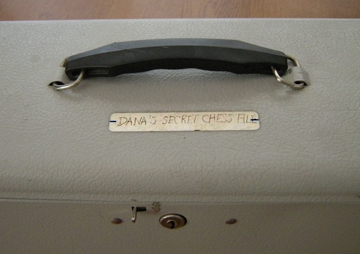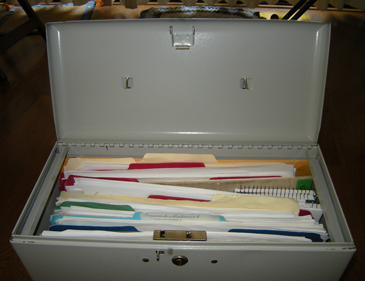(In case you can’t read the writing in this photo, it says “Dana’s Secret Chess File.”)
Yes, that’s right. One of the responses to my post “Taking stock” suggested that I should cover more openings in this blog. So I’m going to do it — in some future entries I’ll post some of the contents of Dana’s Secret Chess File. I guess it won’t be secret any more, huh?
But I’m not going to start today! Before I start unveiling the contents of Dana’s Secret Chess File, I first want to say a few words about Dana’s Opening Philosophy.
The first axiom in my philosophy is that opening theory is a scam! For anyone rated under 2200, that is, and probably even for anyone rated under 2400. If you look at Jesse Kraai’s Step-by-Step Training Guide on chesslecture.com, you will notice that he writes that when you get to the 2400+ level: “Now is the time to take the openings seriously.” No earlier than that. Not when you’re a class D player, or class C, or B, or A, or expert, or even a beginning master.
Why do I say opening theory is a scam, instead of a harmless waste of time? Because grandmasters make a living off of our pathetic belief that if we just knew the openings a little bit better, we could play as well as they do. They write books on openings that are only useful for players over 2400 … but who buys those books? At least 95 percent of the customers are amateurs.
So the first point in Dana’s opening philosophy is to ditch all your opening books, except maybe for a general reference book (I use a 25-year-old copy of Modern Chess Openings.) In particular, you should not pay attention to my opening analysis either! If I ever wrote a book on chess openings, I would call it Do Not Buy This Book. Either that, or I’d make it a blank book that the reader would write in. Unfortunately, I don’t think it would sell very well …
The second point in Dana’s opening philosophy is to do your own analysis. That’s really key. That is part of why I don’t want you to buy my book!
Why do I want you to do your own analysis? Because that’s what the grandmasters do. That’s what makes a Kasparov so good. It’s not because he has memorized the latest innovations in Openings X, Y, and Z — it’s because he discovered the latest innovations in Openings X, Y, and Z! Unfortunately, chess amateurs learn the wrong lesson. Instead of doing what the grandmasters do, which is come up with their own ideas in the openings, they think they can achieve chess mastery by copying the moves the grandmasters play. Sorry! You won’t become a great writer by typing the works of Shakespeare.
Of course, when you do your own analysis, it won’t be as good as the grandmasters’ analysis, and your innovations will not be as good either. Don’t let that dissuade you! Your opponents aren’t grandmasters either. If you are a class-B player, and you’re playing against class-B players, then a well-thought-out innovation that you prepare at home will be as effective as an innovation prepared by a grandmaster. In fact, it may be more effective. Why? Because you will understand your reasons for playing it, and your opponent won’t! The goal of an opening innovation is to force your opponent to think for himself, instead of playing memorized lines.
Now that I’ve told you to come up with your own innovations, you might wonder how. Well, this is a matter of personal style and taste, but what I often look for are good developing moves that are for some reason not the most popular. Look for those #2 or #3 or #4 moves that are in the footnotes of your general opening reference. Better yet, don’t even look at the footnotes. What do you think is the right move in this position? If your answer is different from the most popular book move, it doesn’t mean you’re wrong. Just the opposite! It means that the herd of chess players, in their eagerness to play the orthodox line, have taken leave of their senses and forgotten that there are other good moves in the position.
True, the grandmaster at the head of the herd might have had a very good reason to prefer his move to yours. But the rest of the players in the herd don’t know that. They have no clue why the book move is better than yours. So there are two two things that might happen. Either your move is as good as the book move (in which case, hooray! You’ve just found a TN!) or else the book move is a little bit better but your opponents won’t be able to figure out why. Either way, go ahead and play your move! You’ll come out ahead. Eventually, you might figure out why the book move is better, and then you can go on and play the book move with a clear conscience.
Just make sure that your ideas have some grounding in common sense. I’m not a big fan of playing things like Grob’s Opening (1. g4) because it doesn’t really have a positional basis. As I said, look for moves that seem reasonable but just happen not to be popular.
Finally, use your computer, but use it with caution. It’s like having your own private grandmaster to help you! The computer will spot resources (both for you and your opponent) that you either overlooked or underestimated. But don’t get sucked in too deep by computer analysis. Sometimes a “computer move” will only work if it is followed by a half dozen more computer moves that defy common sense. In that case, you’ve fallen back into the trap of memorizing something you don’t really understand. For this reason, I think that it works better if you can come up with the main idea yourself, and verbalize what you are trying to accomplish with it. Then use the computer to firm up your analysis and maybe spot things that you missed.
Also, if your innovation is a pawn sacrifice, be aware that computers sometimes have trouble evaluating a gambit. They might initially show you as being behind by 0.75 pawns or 0.5 pawns, but then after a few moves (if it really is a good gambit) they will wake up and realize you have full compensation. So don’t be too discouraged by that initial “-0.75” assessment. (On the other hand, if the “-0.75” persists or even gets worse after a few moves, then your innovation is probably not so good.)
So, to sum up:
- Opening theory is a scam (if you are rated under 2400).
- Do your own opening analysis!
- Make the opponent think for himself.
- Look for good developing moves that just happen to be less popular than the main line.
Happy inventing!





